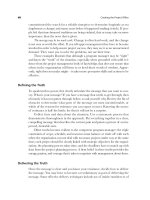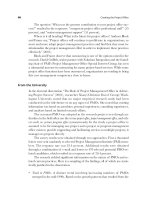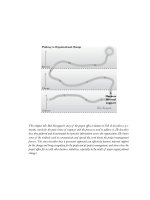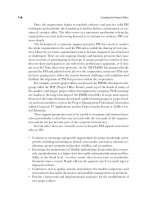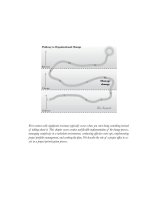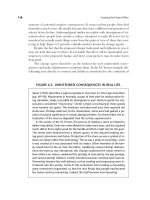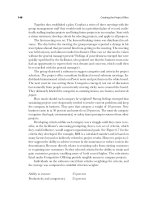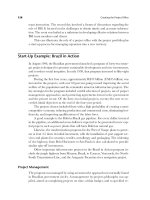Tài liệu Creating the project office 23 ppt
Bạn đang xem bản rút gọn của tài liệu. Xem và tải ngay bản đầy đủ của tài liệu tại đây (111.2 KB, 10 trang )
A few years ago the mayors nearest the base decided they would not sign off
until the Italian government recognized and compensated local municipalities for
the U.S. impact on their respective infrastructures. A boycott of the annual
projects had the potential to bring the entire program to a halt because the proj-
ects involved were on the critical path.
This scenario represents one example of the challenges that affect program
managers working in international, intercultural environments. Responding to
these challenges requires team-building and partnering with local political and
regulatory agencies, introducing modern project management to international
and national organizations, promoting the value of program management, and
effectively integrating a myriad diverse projects into a cohesive program.
Vision
In December 1998, the commander of U.S. and NATO air forces in NATO’s
Southern Region stepped in with a vision of creating a single, full-time program
office to build the base for its customer—the 31st Fighter Wing—freeing the wing
commander and his team to concentrate on the flying mission. Signs from pro-
gram reviews indicated something was wrong. A program that had been under
way since 1994 was in serious trouble—delays, snafus, and lack of focus were just
the symptoms. The Aviano 2000 PMO was to be the “single belly button” for ex-
ecution of the program. A program manager (PM) was selected from within the
base organizational structure and instructed to “make it happen.”
198 Creating the Project Office
Establish sense of
urgency— clear danger
• establish infrastructure:
• people, processes,
and tools
• manage stakeholders
• evolve capabilities
and capacity
• review case studies
Leading
Organizational
Change
to PBO
Create guiding coalition—
powerful forces
Develop vision and
strategy—focus
Manage the change—
short-term wins, broad-based
action, consolidate gains
Develop broad-based action—
keep moving, implementing
Make change stick—
new PBO culture
The tale we tell
Communicate the change
vision—tell the tale
Staff and operate—
In or out?
Sense of Urgency
Sorting out the players was a critical first task for the program manager. Evalua-
tion of available resources revealed no slack available to start up and run a pro-
gram office. He would have to establish requirements and compete for each and
every resource.
The NATO screening process, by which the alliance reviews proposed projects
at the 35 percent design stage, approves individual project scope, and authorizes
final funding, had bogged down due to a lack of project screeners and a heavy
workload. This action delayed final designs and construction awards, putting the
program at great risk against the schedule.
The PM’s assessment of his tasks, program scope, operating environment, re-
sources, and program status indicated that, despite the extraordinary work put in
by everyone involved in the initial years of the program, it was now at a point
where drastic change was needed to avoid failure.
What had been a hair-on-fire approach to project management between 1995
and 1997 had gradually turned into business as usual. Top-level leadership, which
had been the key to early success in the planning stages, no longer participated fre-
quently in program reviews. Functional managers were executing this multiple-project
program as routine work—emphasizing individual projects, not the overall program.
Despite the fact that there were sixty major NATO projects to be completed in the
program, formal project teams were not established to manage any of them.
Project managers had been assigned from three different organizations: Head-
quarters, U.S. Air Forces in Europe (USAFE), the base civil engineer squadron, and
the two design and construction agents—Italy and the U.S. Navy. Project managers
from each organization thought they were in charge of the project. In reality, their
responsibilities, which had not been formally defined, were shared, and no one re-
ally had authority or accountability for the projects. As a result, decisions were fre-
quently kicked up to senior management and, in many cases, to program sponsors.
Problems began to arise together with finger pointing. It was impossible to pinpoint
root causes for actions not completed, delays, or other problems.
This situation manifested in poor communications, busted deadlines, dispro-
portionate workloads, crisis management, lack of budget controls, functional man-
agers who were not supporting the program, minimal customer focus, a limited
quality program, and a lack of basic processes for change, issue resolution, deci-
sion making, and financial choices. The process was loose and inefficient. Project
controls were lacking, and there was no schedule to track status. Most critical,
there were not enough people available to handle the enormous workload.
Keep Moving 199
The fundamental disconnect? No one was truly in charge of either the over-
all program or individual projects. Despite being the USAF’s largest ground-up
construction program, it was managed by functional managers at headquarters
in Germany and spread throughout the engineering, contracting, and communi-
cations functions of the fighter wing. To complicate the effort, the fighter wing in
1995 was occupied full time with the planning and execution of air combat op-
erations in the Balkans.
Course of Action
The program had two critical needs: a program management methodology and
a formalized, project-based approach.
Conscious of the need to attack the dual challenges of keeping the program
moving and establishing the PMO, the program manager plotted his course of
action. He struck a deal to take immediate operational control of a number of
engineers assigned to the wing’s civil engineering function. He assigned projects
and gave engineers authority as single project managers to keep their projects
moving forward—a cradle-to-grave approach—that included leading project de-
livery teams and acquiring furniture and equipment. The next complication was
his discovery that, although the assigned engineers were called project managers,
they were not really project managers at all. Only one had actual project man-
agement experience or formal training. They were technical project engineers. It
became a matter of turning those who showed the desire into PMs—easier said
than done. Instead three elected not to remain with the program for personal rea-
sons, and their departure left the program shorthanded.
The program had to move ahead. Because the personnel system did not
work fast enough to hire permanent staff, the program manager brought in re-
placements on Temporary Duty, known as TDY basis, to fill the gaps. Four en-
gineers for ninety days cost about $75,000 for transportation, billeting, and per
diem expenses. Had the people who were already present filled the bill in the
transformation to a project-based organization, those costs could have been
avoided.
A call went to all Air Force engineering units seeking TDY personnel who
could “work in the largest AF construction program and enjoy Italy at the same
time.” The urgency of the situation required the program manager, for the first
time, to outline what he was looking for in project managers for both the short
and long term. The outline set one of the baselines for their Program Manage-
ment Methodology. He sought experienced construction managers (engineers or
architects) who were technically qualified in large construction projects (ideally in
200 Creating the Project Office
multiproject programs), and who had actual project management training and
experience plus appraisals that showed they had supervisory, team leadership, and
communicative skills—that is, a mixture of technical competence and skills, a
grounding in project management, and proven leadership ability. He also sought
people of higher rank, at the GS-13 level, with long experience in Air Force en-
gineering. That was not easy because GS-13s are already in good jobs, usually as
deputies of civil engineering squadrons. The enticement was the chance to come
to Italy, a new overseas experience for many of them.
Colonel Gary LaGassey, the program manager, says,
I determined that as long as I was going to shell out so much money, I would
go for the best. We canvassed all major Air Force commands asking for help.
We had many takers because there were lots of people who wanted to come
to Italy for a ninety-day stint. We had the luxury of being pretty selective,
therefore, I set the marker as high as I could in terms of technical qualifica-
tions, experience and, enthusiasm.
I have long been a believer in enthusiasm as a prerequisite in hiring.
Project management is all about team building, and team building is all about
passion for a task and enthusiasm in carrying it out. Also, I’m a believer that
enthusiasm can make the average person great. In my career I’ve seen many
“big brains” or “hotshots” that don’t work well in the team situation. I’ll go
with the above-average person with enthusiasm every time!
An interesting side note, we took the same approach twice in 1999 and
again in 2000 when we experienced additional shortages. Of those people who
came here TDY, we later hired two of them permanently. What we established
as our prerequisites (technical and PM experience, team leading skills, and so
on) still stand as part of our evaluation process in the hiring game. The best
part of our success had been the fact that we earned Air Force-wide reputation
as a quality organization so we can screen applicants and select only those who
meet our standard. That’s a good position to be in.
With the goal of obtaining a systematic approach to the workload and creat-
ing balance among the PMs, he reassigned work and laid out a priority of action.
Realizing that it all could not be done with the resources available, he developed
a plan to seek additional people.
The next step was building a preliminary (and very rough) program method-
ology, called the “Approach for Aviano 2000 Project Managers.” The basis of this
methodology was a back-of-the-envelope work breakdown structure that focused
on overall goals for the Aviano 2000 program. Looking back on the methodology
(see Figure 8.1), it is easy to see just how primitive it was—but it worked.
Keep Moving 201
Using principles of project management contained in A Guide to the Project Man-
agement Body of Knowledge, established by the Project Management Institute (PMI),
the centerpiece of the methodology was that for the eighty-five NATO projects,
the PMO would become a truly project-based organization. Steps included
1. Sort the elements of a successful program and individual projects.
2. Assess tools needed by the program team to achieve success.
3. Draft simple mission, program scope, charter, and vision statements. Again,
these were rudimentary in nature. The principal objective of having these in
the Approach was to get preliminary buy-in from players who felt they were
being forced into a program management system.
4. Develop a nominal organizational structure, a rough framework to be used to
convince the project sponsor of program needs and to gain his support in
the fight for resources.
5. Rough out an operating budget. (Including salaries for temporary hires and
contract personnel, the Aviano 2000 budget was initially estimated at $1.8 mil-
lion a year. Sticker shock ensued!)
6. Lay out a preliminary scheduling program that would be used to manage
the projects from a programmatic view.
202 Creating the Project Office
FIGURE 8.1. APPROACH FOR AVIANO 2000 PROJECT MANAGERS.
Two Parts
• A fully integrated
PM Process
• Integrated PM Tools
Project
Management
• Schedule
• Database
• Funding
• Web Page
• Reviews
Safety
Management
Risk
Management
Change
Management
Quality
Management
Tools
Comm
Management
Personal
Development
